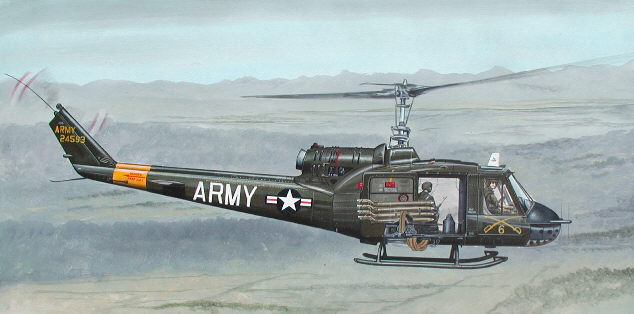The “Huey” as it was called after it's original model designation, the HU-1, was essentially a stretched Bell (model 47) Sioux with room for 7 troops or three stretchers in it's cargo compartment behind the pilot. It was re-designated as the Utility Helicopter UH-1 in 1962 under a tri-service agreement. The HU-1A Iroquois, initially procured by the Army in 1959 as a general utility helicopter, was the first model ordered in large numbers. Since 1959, the “Huey” has evolved through 13 models, A thru V. It saw wide use in Vietnam following initial fielding in September 1962. The “Huey” saw service with the 82nd Airborne Division, the 101st Airborne Division, and the 57th Medical Detachment. The “Huey” became the basis for the creation of the 1st Aviation Brigade in 1966.
“Hueys” armed with only two M60D door guns, called “Slicks” because of their uncluttered external appearance, were the backbone of all airmobile combat operations in Vietnam. Unarmed MedEvac “Hueys” were called “Dust Offs”, because of the clouds of dust kicked-up, when landing. The “Huey” replaced the CH-21 Shawnee in the combat assault role. The UH-1 had a two-bladed semi-rigid metal main rotor, a two-bladed semi-rigid metal tail rotor and had a speed of 104 mph (90 knots).
The (Bell model 204) UH-1A (1956) seated seven troops. The UH-1A was powered by a Lycoming turbine T53-L-1A 860 shp (shaft horse power) engine.
The (Bell model 204B) UH-1B (1960) seated nine troops. The UH-1B featured two long FM homing antennas and the pitot tube on the nose, and a large single window in the doors. The UH-1B was was powered by several Lycoming turbine engines; T53-L-5 960 shp, T53-L-9A 1100 shp, and T53-L-11D 1100 shp. The UH-1B had a cruising speed of about 105 mph (90 knots).
The UH-1C (1965) could seat nine troops, had an improved rotor, and a greater range. The UH-1C was powered by a single Lycoming T53-L-11D 1100 shp engine. The rotor head was the “540” rotor system, used only on the UH-1C (and the UH-1M). This was the prototype of the rotor system later used, without stabilizer bar and dampers, on the AH-1G Cobra. The chord of the rotor blades (distance from the leading edge to the trailing edge) was much longer on the UH-1C than on all other model “Hueys”. The UH-1C also featured a brace extending from the aft fuselage to the weapons mount. This support was only used on the UH-1C and the UH-1M, an engine upgrade to the UH-1C. These aircraft were also the only “Hueys” with the fuel filler cap located on the left side of the fuselage.
The UH-1M was a small number of UH-1C models that were upgraded to the more powerful Lycoming T53-L-13B 1400 shp engine for use in Vietnam. The first three UH-1Ms were were equipped with the INFANT (Iroquois Night Fighter and Night Tracker) system for night operations. All remaining UH-1Ms were simply UH-1Cs with the T53-L-13B engine upgrade.
The “Huey” is the most universal military aircraft of the modern era, serving in all four branches of the American uniformed services and in the armed forces of at least 48 other nations. The MedEvac version was the UH-1V.
Information courtesy of the Army Aviation History Website
|




